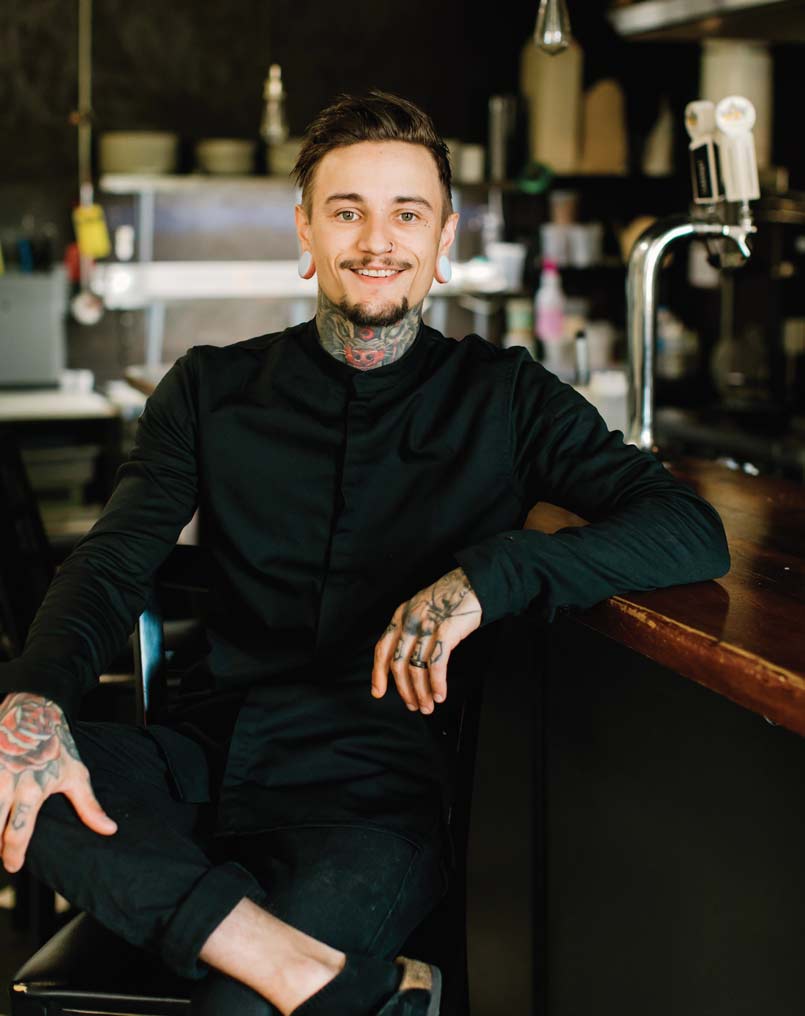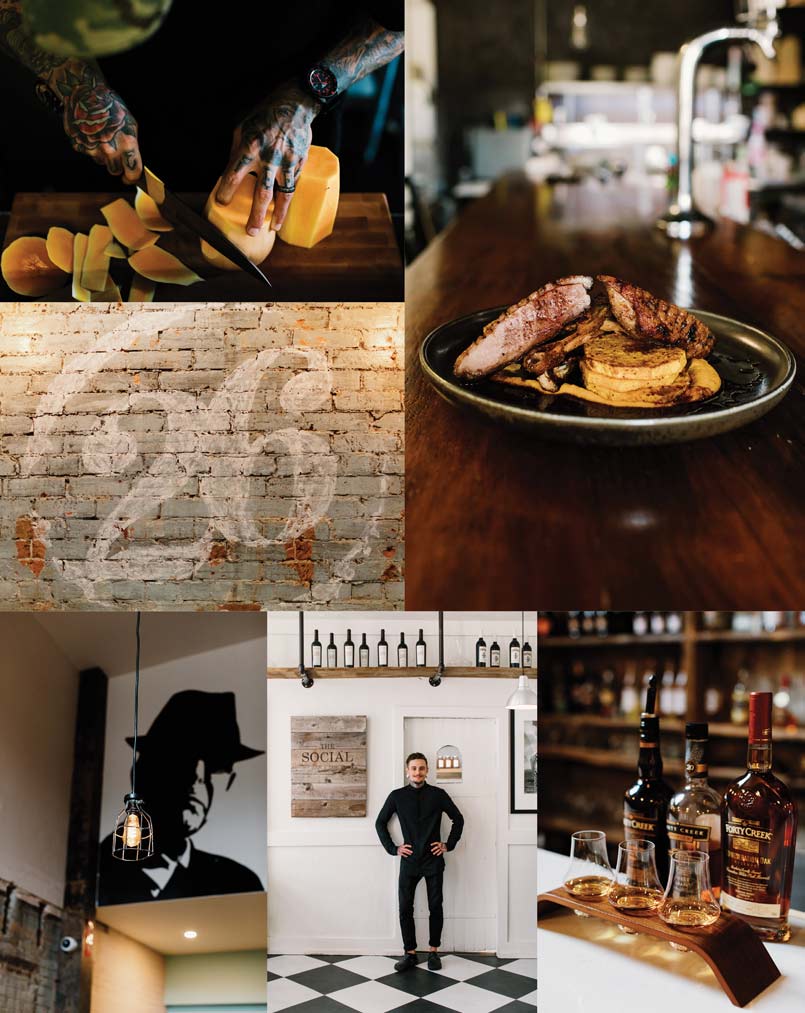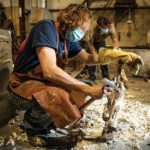


Dave Kranenburg | Kendal Hills Farm; Tenisha Patterson | Ariza Creamery; James Harley | Harley Farms
Two restaurants, two patios, two menus, two vibes, and one very busy chef. At The Social Bar + Table and its sister bistro, TwentySix, Chef Liam Potvin is showing Port Hope what he can do – and getting in his cardio at the same time.
The quaint little town of Port Hope is in flux. Since the start of the pandemic in 2020, house prices have shot up at least 35 per cent as more and more city-weary folks discover a quality of life just not possible in Toronto.
But can this lakeside town of almost 17,000 offer the contemporary, casually elegant and affordable cuisine that urbanites are used to from their former downtown neighbourhoods. Well, it’s coming and Chef Liam Potvin can take some credit for this. He’s got his hands full with The Social Bar + Table and its sister restaurant, Twenty- Six. Good thing he’s got youthful energy, a crystal clear vision and drive to spare. Co-owners Laurie Carr and Julie Mavis took over the tiny space – formerly The Hedgehog – when the owner shuttered the German-style pub. “It was where we could go and sit in peace to do the Globe and Mail cryptic crossword on the weekend,” says Julie. “When it closed, we thought, now where will we go?” So in 2014 the enterprising couple – together they also own Cats Media – took over the place and started serving burgers and beer. Seven years and four chefs later, the space and the menu have evolved and matured – and with the addition of TwentySix, the food and drink scene in this little town just got exciting.
At TwentySix – named for the address on Ontario Street – it’s all about Canadian whisky, well-crafted cocktails, small plates, and the raw bar, which is stocked on Thursdays with Canadian oysters, Argentinian shrimp, lobster tails and snow crab. Bar manager and mixologist, Wes Galloway, has curated a list of about a dozen special whiskies – he offers whisky tasting flights – and around 20 classic and contemporary cocktails to pair with Chef Potvin’s short menu of raw bar and bistro classics. The Social is a cosy and casual beer and wine bar combining comfort food with haute cuisine made from local ingredients.
Laurie and Julie entrusted architect Phil Carter and designer Sheilagh Fletcher to work on both The Social and TwentySix, which sit side by side in a 170-year-old heritage building that once housed a cabinet maker and undertaker. For TwentySix, the design team created an impressive, soaring room by pulling out two floors and repurposing the antique wood throughout the space. A huge glossy black decal of a fedora-ed Leonard Cohen – is there a better drinking companion? – presides over the room of exposed brick, plaster remnants and ancient timber beams. The atmosphere is wonderfully, quirkily Canadian. “We always wanted our place to be inclusive,” says Julie. “And local: local ingredients and local artists on the walls – and it has been from Day One.”
The Social and TwentySix are Ontario Living Wage Network certified employers. To qualify, they pay all employees the living wage rate for their region. “We changed our entire structure to ready ourselves for certification,” says Julie. “We had in the past a very traditional restaurant model, but we saw the disparity between pays and we were determined to become a One Fair Wage and Ontario Living Wage restaurant.
“This move has changed the entire culture of our restaurant, which demonstrates a stronger sense of teamwork and collaboration,” she continues. “Employees now earn a living wage, receive a health benefit package and share in the tip pool. It has not been an easy transition but it is one that I believe the restaurant industry in general is moving toward. The old model is broken – it’s time to change.”
Inclusivity is the ethos Chef Liam Potvin brings to his menus, too. “I’d describe my food as internationally inspired contemporary Canadian farm-to-fork cuisine,” he says. “We make about ninety-nine per cent of the menu from scratch, but I do bring in the ice cream from a small, local creamery.”
Liam has worked in kitchens since he was 13. “My first job was flipping burgers at Burger King,” he recalls. “Then at 14, I got a job at a decent Italian joint in Blue Mountain.” He was a dishwasher, food runner, busser and prep cook, and every now and then the chefs at Magnone’s Italian Kitchen would teach him a pasta dish. “The sauces weren’t amazing, but I learned a valuable lesson: the kitchen – and a busy service – lives or dies by the dishwasher.”
His mom and dad both cooked. According to Liam, they were simple but good cooks, and he was always involved in the cooking. “I even still have notebooks from when I was 12,” says Liam, “with notes about recipes.” His mom is of Ukrainian and Polish decent, and his dad is French Canadian. “Mom is the one with a more adventurous palate,” he says. “Like me, there’s nothing she won’t try at least once. My dad on the other hand is a very safe eater – hot dogs, spaghetti, burgers – that sort of thing.”
By the age of 16, Liam was managing his hometown Swiss Chalet in Wasaga Beach. It was here he learned how to handle volume without losing his cool, a skill that comes in very handy now that he’s responsible for two establishments, several menus that change with the seasons, a kitchen staff of five, and seven-day-a-week service. It’s not uncommon for him to put in as many as 65 hours in a week. And now, with both dining rooms under his watch, it’s also not uncommon to see him darting back and forth, making sure the plates are coming out just the way he envisioned them.
Despite his resumé, cooking wasn’t always his passion; it had always been just a job. “From the time I was very young I’ve worked,” says Liam. “And I was just always drawn to the kitchen and jobs in restaurants. I didn’t really think about why. My parents didn’t hand me money, so if I wanted something, I had to go out and earn enough to buy it for myself. And it’s not that we were poor – we were an upper-middle-class family – it’s just how they raised me.”
“I’m driven, one hundred per cent,” he states. That drive was eventually joined by a passion for food and cooking. Choosing to study Culinary Management at Algonquin College, he flourished in an accelerated, two-year apprenticeship program under Chef Kyle Proulx, at Lowertown Brewing in Ottawa’s bustling ByWard Market. It was there he also met the young woman who would become his wife and the mother of his two little girls, Aria and Zara. Their names are tattooed down each of his cheeks like sideburns.
Even with the most cursory of glances, one can’t help but be intrigued by the chef’s look – Urban Primitive, perhaps? – with large ear spacers and elaborate tattoos covering much of his body. Liam is a visual chef, attracted to imagery.
“I find inspiration in nature,” he says. “I might see something on a walk in the woods, or maybe a painting or something, and that will give me an idea for a dish. And then I’ll see the whole finished plate in my head.” But he adds, “I’m still sort of finding my niche. I come in every day knowing what I want to do and I’m getting better at it all the time. I have my vision and I’m pushing my technique, flavours, plating, the look of the dishes.”
Juniper and Maple Pan-roasted Duck Breast with Butternut Squash
The beautiful colours of autumn leaves and iconic Canadian flavours are my inspiration for this dish. If you can’t find blue oyster mushrooms, regular oyster mushrooms can be substituted; or if you’re really in a pinch you could slice some shiitake.
Ingredients
2 duck breasts
2 cloves garlic
1 tsp dried juniper berries
1 tbsp maple syrup
4 tbsp canola oil; divided
1 smallish butternut squash
Pinch ground nutmeg; freshly grated is best
150g blue oyster mushrooms; about a small handful, torn into smaller pieces
1 tsp Kosher or sea salt; divided
1 tsp black pepper; divided
3 tbsp butter; divided
½ cup dry red wine; a cabernet sauvignon or merlot would work well with this dish
Directions
- Preheat oven to 400º F.
- Line a baking sheet with parchment paper
- With the tip of a sharp knife, make shallow crosshatch cuts through the skin and fat cap of the duck breasts; set aside.
- Into a blender, add garlic, juniper, maple syrup, and 2 tablespoons oil; blend on high until smooth. Transfer to a bowl and add duck, tossing to coat well with marinade; set aside to marinate for a minimum of 10 minutes to overnight.
- Trim ends from the squash, peel, use a spoon to scoop out the seeds, then cut into 1” rounds.
- In a medium mixing bowl, add mushrooms, squash rounds, nutmeg, ¼ teaspoon each of salt and pepper, and remaining 2 tablespoons oil; toss well to coat evenly. Spread on prepared baking sheet. Roast for about 10 minutes or until squash is tender when poked with a fork.
- While squash and mushrooms are roasting, heat a cast iron pan over medium heat.
- Gently wipe duck and season with salt and pepper. Place duck on hot, dry pan, skin side down and cook for 2 – 4 minutes or until skin is golden and crispy. The duck will render its fat for cooking the second side. Flip duck and reduce heat to low. Add 2 tablespoons of butter to pan. Tip the pan to collect the fat, baste the duck frequently with a spoon as you continue to cook to medium rare – internal temperature of 135º F – or about 8 minutes. Transfer duck to plate and allow to rest for 6 minutes.
- Drain half the fat from the pan, then return pan to high heat, add the wine and stir until reduced by half. Swirl in 1 tablespoon of butter – cold is best. Season with salt and pepper to taste.
- Add half of roasted squash rings to a blender or food processor with ¼ cup warmed 35% cream and a pinch of salt and blend on high to a smooth purée.
- To serve, add a generous dollop of the squash purée to each plate, top with mushrooms and reserved squash rings. Slice the duck diagonally lengthwise and arrange on top of the mushrooms. Drizzle with the sauce. Serves 2
Chef’s Tip: Save that precious poured-off duck fat for roasting scrumptious potatoes or simply smearing on toasted baguette
Dave Kranenburg | Kendal Hills Farm
In Orono, co-owner Dave Kranenburg and his wife Emily raise chicken, turkey, quail, duck, goose, pork, rabbit and gourmet mushrooms on 70 acres of rolling hills and woodland, in the Oak Ridges Moraine. Practising regenerative agriculture, Dave and Emily repurposed an old cinderblock chick brooder shed to grow a wide variety of specialty mushrooms: oysters, pioppino, beech, lion’s mane, black pearl. The blue oyster mushrooms featured in Chef Potvin’s recipe were grown here.
Dave and Emily grow their mushrooms on sawdust and once the mushrooms have been harvested, the leftover growing medium will serve as compost for their tree-planting and vegetable gardens.
“We grow indoors,” says Dave. Built into the hillside, the shed is naturally insulated, keeping it warmer in the winter and cooler in the summer, while the south-facing windows ensure some indirect sunlight so they develop bright natural colours and rich flavour.”
“I enjoy working with Kendal Hills,” says Chef Liam Potvin “because Dave is a really personable guy. He always figures out a solution if there’s a supply problem. Not to mention his mushrooms are absolutely gorgeous and the quality is exceptional.”
Tenisha Patterson | Ariza Creamery
Since 2021 Tenisha Patterson has been making small-batch, artisanal ice cream, first as a hobby – a treat for friends and family – but soon, all the positive feedback gave her the push to go pro, and she’s never looked back.
Based in Oshawa, the mother of two and child and youth worker, makes about 12 litres of ice cream each week – more or less, depending on orders – in two flavours, one dairy and one vegan. Her 25 original flavours are inspired by her favourite desserts. “I love ice cream,” says Tenisha. “I just think about how I can turn my favourite dessert into a frozen treat.”
Tenisha makes everything from scratch, from the base – fresh cream or coconut cream – to the add-ins and flavourings, and when she uses fruit, it is always fresh. And while it’s true she does have an in with Chef – they’ve been married since 2017 – and it might be fair to assume Chef Liam Potvin is a tad biased, we can vouch for him. It’s really good stuff.
“I admire her work ethic,” says Liam. “The fact that she makes the time to consistently put out orders, and that it’s the best ice cream I’ve ever had. It’s so creamy and delicious; she is very creative and has new flavours every single week. She also sells vegan ice cream and it is incredible.”
www.facebook.com/arizacreamery
James Harley | Harley Farms
Originally from East Kennett, England and now farming in Keene, Ontario, Roger and Julie Harley, along with children James and Emily, raise heritage pigs, sheep, poultry and cattle on approximately 1,500 lush, rolling acres. The superlatives are many – SPCA Certified, grass-fed, humane, natural, 100 per cent GMO free, free-range, sustainable, regenerative and local – you can even book a farm tour to see for yourself.
As regenerative farmers, their animals are always on the move, grazing on grassland and fed crops grown on the farm: sorghum, clover, oats, peas, hay and other grasses. Another tenet of this style of sustainable farming is offering shelter to livestock as opposed to housing or confining them. The Harleys’ animals enjoy the freedom to exist in family groups.
And while all this is important to Chef Liam Potvin, taste and texture comes first. It’s their beef from High Welfare Galloway and Hereford cattle that Liam crafts into The Social burger, a mainstay on the menu.
“The lean, grass-fed, ground beef from Harley Farms is tasty and juicy and doesn’t need any filler,” says Liam. “I just let the cattle James has raised with care, shine. And it does, our classic burger is one of our top sellers.”
Story by:
Signe Langford
Photography by:
Chantelle Watt




